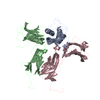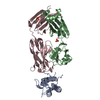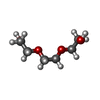+Search query
-Structure paper
| Title | Structure and antagonism of the receptor complex mediated by human TSLP in allergy and asthma. |
|---|---|
| Journal, issue, pages | Nat Commun, Vol. 8, Page 14937, Year 2017 |
| Publish date | Apr 3, 2017 |
 Authors Authors | Kenneth Verstraete / Frank Peelman / Harald Braun / Juan Lopez / Dries Van Rompaey / Ann Dansercoer / Isabel Vandenberghe / Kris Pauwels / Jan Tavernier / Bart N Lambrecht / Hamida Hammad / Hans De Winter / Rudi Beyaert / Guy Lippens / Savvas N Savvides /    |
| PubMed Abstract | The pro-inflammatory cytokine thymic stromal lymphopoietin (TSLP) is pivotal to the pathophysiology of widespread allergic diseases mediated by type 2 helper T cell (Th2) responses, including asthma ...The pro-inflammatory cytokine thymic stromal lymphopoietin (TSLP) is pivotal to the pathophysiology of widespread allergic diseases mediated by type 2 helper T cell (Th2) responses, including asthma and atopic dermatitis. The emergence of human TSLP as a clinical target against asthma calls for maximally harnessing its therapeutic potential via structural and mechanistic considerations. Here we employ an integrative experimental approach focusing on productive and antagonized TSLP complexes and free cytokine. We reveal how cognate receptor TSLPR allosterically activates TSLP to potentiate the recruitment of the shared interleukin 7 receptor α-chain (IL-7Rα) by leveraging the flexibility, conformational heterogeneity and electrostatics of the cytokine. We further show that the monoclonal antibody Tezepelumab partly exploits these principles to neutralize TSLP activity. Finally, we introduce a fusion protein comprising a tandem of the TSLPR and IL-7Rα extracellular domains, which harnesses the mechanistic intricacies of the TSLP-driven receptor complex to manifest high antagonistic potency. |
 External links External links |  Nat Commun / Nat Commun /  PubMed:28368013 / PubMed:28368013 /  PubMed Central PubMed Central |
| Methods | SAS (X-ray synchrotron) / X-ray diffraction |
| Resolution | 2.298 - 2.56 Å |
| Structure data |  SASDB99:  PDB-5j11:  PDB-5j13: |
| Chemicals |  ChemComp-PGE:  ChemComp-NAG:  ChemComp-HOH:  ChemComp-SO4: |
| Source |
|
 Keywords Keywords | SIGNALING PROTEIN / cytokine inflammation TSLP signaling complex / IMMUNE SYSTEM / cytokine inflammation TSLP antibody |
 Movie
Movie Controller
Controller Structure viewers
Structure viewers About Yorodumi Papers
About Yorodumi Papers



 homo sapiens (human)
homo sapiens (human)